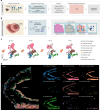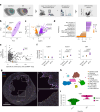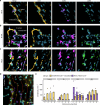Spatial multiomics of acute myocardial infarction reveals immune cell infiltration through the endocardium
- PMID: 41044418
- PMCID: PMC12520975
- DOI: 10.1038/s44161-025-00717-y
Spatial multiomics of acute myocardial infarction reveals immune cell infiltration through the endocardium
Abstract
Myocardial infarction (MI) continues to be a leading cause of death worldwide. Even though it is well established that the complex interplay between different cell types determines the overall healing response after MI, the precise changes in the tissue architecture are still poorly understood. In this study, we generated an integrative cellular map of the acute phase after murine MI using a combination of imaging-based transcriptomics (Molecular Cartography) and antibody-based highly multiplexed imaging (Sequential Immunofluorescence). This enabled us to evaluate cell type compositions and changes at subcellular resolution over time. We observed the recruitment of leukocytes to the infarcted heart through the endocardium and performed unbiased spatial proteomic analysis using Deep Visual Proteomics (DVP) to investigate the underlying mechanisms. DVP identified von Willebrand factor (vWF) as an upregulated mediator of inflammation 24 hours after MI, and functional blocking of vWF reduced the infiltration of C-C chemokine receptor 2 (Ccr2)-positive monocytes and worsened cardiac function after MI.
© 2025. The Author(s).
Conflict of interest statement
Competing interests: D.S. reports funding from GlaxoSmithKline and receiving fees/honoraria from ariadne.ai, GlaxoSmithKline, Immunai, Noetik, Alpenglow and Lunaphore. K.B. reports fees from Lunaphore. J.S.R. reports funding from GlaxoSmithKline, Pfizer and Sanofi and fees/honoraria from Travere Therapeutics, Stadapharm, Astex, Owkin, Pfizer and Grunenthal. F.W. is an employee of Seqera. The other authors declare no competing interests.
Figures













References
-
- Yan, X. et al. Temporal dynamics of cardiac immune cell accumulation following acute myocardial infarction. J. Mol. Cell. Cardiol.62, 24–35 (2013). - PubMed
MeSH terms
Substances
LinkOut - more resources
Full Text Sources
Medical
Miscellaneous
